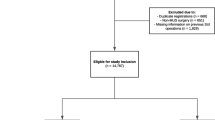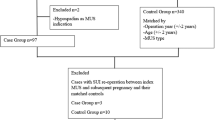Abstract
Introduction and hypothesis
To evaluate the continence status and to reveal the optimal delivery mode of women who had an infant after application of a midurethral sling to treat stress urinary incontinence.
Methods
Between January 2007 and January 2013, 12 women who delivered an infant after application of a midurethral sling were detected and demographic data, type of MUS, interval between MUS and delivery, mode of delivery, birth weight of the newborn, complications during pregnancy, and continence status after delivery were collected. Between 2000 and 2014, in 14 articles listed in Pubmed, the data of 54 patients who had delivered after successful midurethral sling application were included. Postpartum recurrence of urinary incontinence was evaluated according to delivery type in 54 patients.
Results
Mean age of 12 patients at the time of MUS was 33.1 ± 4.3 years old and the interval between MUS procedure and pregnancy was 30.2 ± 14.2 months. Four patients had a transvaginal tape (TVT; 33.3 %) and 8 had transobturator tape (TOT) procedure (66.7 %) and mean follow-up after MUS surgery was 52 ± 12.3 months. Seven women had cesarean section (CS; 58.3 %) and 5 women delivered vaginally (41.7 %). Nine women were continent during pregnancy (75 %) and 10 were continent after delivery (83.3 %). Among 54 women who were included in the review, 28 underwent CS (51.9 %), 26 women delivered vaginally (48.1 %), and 11 women had postpartum incontinence (20.3 %). In the case of postpartum urinary incontinence, there was no statistically significant difference between the CS and vaginal delivery groups (14.3 vs 26.9 % respectively, p = 0.32). In logistic regression, incontinence during pregnancy was a risk factor for postpartum incontinence (OR:5.5; 95 % CI: 1.1–27.6, p = 0.036).
Conclusion
Risk of postpartum SUI recurrence in women who underwent application of midurethral slings seems to be similar independent of delivery mode and incontinence during pregnancy may be a risk factor for postpartum incontinence.
Similar content being viewed by others
References
Hannestad YS, Rortveit G, Sandvik H, Hunskaar S, Norwegian EPINCONT study (2000) Epidemiology of Incontinence in the County of Nord-Trøndelag A community-based epidemiological survey of female urinary incontinence: the Norwegian EPINCONT study Epidemiology of Incontinence in the County of Nord-Trøndelag. J Clin Epidemiol 53:1150–1157
Peyrat L, Haillot O, Bruyere F, Boutin JM, Bertrand P, Lanson Y (2002) Prevalence and risk factors of urinary incontinence in young and middle-aged women. BJU Int 89:61–66
Reddy J, Paraiso MF (2010) Primary stress urinary incontinence: what to do and why. Rev Obstet Gynecol 3:150–155
Kirby AC, Nager CW (2013) Indications, contraindications, and complications of mesh in the surgical treatment of urinary incontinence. Clin Obstet Gynecol 56:257–275
Lee E, Nitti VW, Brucker BM (2012) Midurethral slings for all stress incontinence: a urology perspective. Urol Clin N Am 39:299–310
Iskander MN, Kapoor D (2000) Pregnancy following tension-free vaginal taping. Int Urogynecol J Pelvic Floor Dysfunct 11:199–200
Lynch CM, Powers AK, Keating AB (2001) Pregnancy complicated by a suburethral sling: a case report. Int Urogynecol J Pelvic Floor Dysfunct 12:218–219
Gauruder-Burmester A, Tunn R (2001) Pregnancy and labor after TVT-plasty. Acta Obstet Gynecol Scand 80:283–284
Seeger D, Truong ST, Kimmig R (2006) Spontaneous delivery following tension-free vaginal tape procedure. Int Urogynecol J Pelvic Floor Dysfunct 17:676–678
Vella M, Robinson D, Brown R, Cardozo L (2007) Pregnancy and delivery following tension-free vaginal tape. Int Urogynecol J Pelvic Floor Dysfunct 18:347–348
Hassan MS, Yossri N, Davies A (2007) Vaginal delivery after surgical treatment for stress incontinence using transobturator tape: a case report. BJOG 114:113–114
Sergent F, Marpeau L (2007) Recurrence of stress urinary incontinence after tension-free vaginal tape and childbirth. Gynecol Obstet Fertil 35:1239–1241
Demaria F, Chanelles O, Boquet B, Bricou A, Amarenco G, Benifla JL (2007) Vaginal delivery after tension-free vaginal tape procedure. Int Urogynecol J Pelvic Floor Dysfunct 18:1363–1365
El-Ghobashy A, Haw W, Brook G, Calvert S (2007) Pregnancy after TVT-O: case report and literature review. Int Urogynecol J Pelvic Floor Dysfunct 18:1491–1493
Groenen R, Vos MC, Willekes C, Vervest HA (2008) Pregnancy and delivery after mid-urethral sling procedures for stress urinary incontinence: case reports and a review of literature. Int Urogynecol J Pelvic Floor Dysfunct 19:441–448
Panel L, Triopon G, Courtieu C, Marès P, de Tayrac R (2008) How to advise a woman who wants to get pregnant after a sub-urethral tape placement? Int Urogynecol J Pelvic Floor Dysfunct 19:347–350
Kohorst F, Flock F, Kreienberg R, Reich A (2010) Pregnancy and delivery after tension-free vaginal tape (TVT) procedure: literature review and case report. Eur J Obstet Gynecol Reprod Biol 151:10–13
Sedlakova K, Huser M, Belkov I (2011) Vaginal delivery after tension free vaginal tape insertion. Prakt Gynekol 15:42–46
Adams-Piper E, Darbinian J, Postlethwaite D, Castillo PA (2014) Pregnancy after transvaginal sling for stress urinary incontinence: a case series. Female Pelvic Med Reconstr Surg 20:212–215
Hantoushzadeh S, Javadian P, Shariat M, Salmanian B, Ghazizadeh S, Aghssa M (2011) Stress urinary incontinence: pre-pregnancy history and effects of mode of delivery on its postpartum persistency. Int Urogynecol J 22:651–655
Viktrup L, Lose G, Rolff M, Barfoed K (1992) The symptom of stress incontinence caused by pregnancy or delivery in primiparas. Obstet Gynecol 79:945–949
Rortveit G, Hannestad YS, Daltveit AK, Hunskaar S (2001) Age- and type-dependent effects of parity on urinary incontinence: the Norwegian EPINCONT study. Obstet Gynecol 98:1004–1010
Gyhagen M, Bullarbo M, Nielsen TF, Milsom I (2013) A comparison of the long-term consequences of vaginal delivery versus caesarean section on the prevalence, severity and bothersomeness of urinary incontinence subtypes: a national cohort study in primiparous women. BJOG 120:1548–1555
Shveiky D, Sokol AI, Iglesia CB (2010) A case report of antepartum bladder outlet obstruction following transobturator sling placement. Int Urogynecol J 21:379–381
Huser M, Belkov IA, Janku P, Sedlakova K (2012) Pregnancy and delivery following midurethral sling surgery for stress urinary incontinence. Int J Gynaecol Obstet 119:117–120
Pollard ME, Morrisroe S, Anger JT (2012) Outcomes of pregnancy following surgery for stress urinary incontinence: a systematic review. J Urol 187:1966–1970
Arunkalaivanan AS, Barrington JW (2003) Questionnaire-based survey on obstetricians and gynaecologists’ attitudes towards the surgical management of urinary incontinence in women during their childbearing years. Eur J Obstet Gynecol Reprod Biol 108:85–93
Conflicts of interest
None.
Author information
Authors and Affiliations
Corresponding author
Rights and permissions
About this article
Cite this article
Cavkaytar, S., Kokanali, M.K., Ozer, I. et al. Effect of pregnancy and delivery on urinary incontinence after the midurethral sling procedure. Int Urogynecol J 26, 693–698 (2015). https://doi.org/10.1007/s00192-014-2568-6
Received:
Accepted:
Published:
Issue Date:
DOI: https://doi.org/10.1007/s00192-014-2568-6




